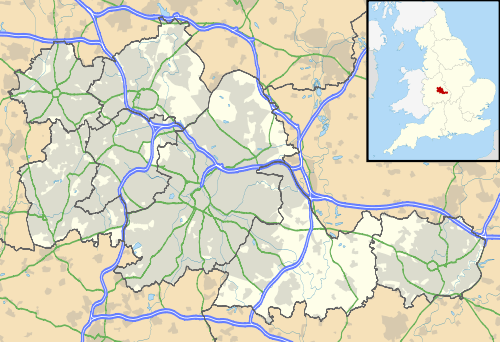Old Town Hall, Wolverhampton
The old Town Hall is a former municipal facility in North Street, Wolverhampton, West Midlands, United Kingdom. It is a Grade II listed building.[1]
| Old Town Hall | |
|---|---|
.jpg) Old Town Hall | |
| Location | North Street, Wolverhampton |
| Coordinates | 52.5861°N 2.1304°W |
| Built | 1871 |
| Architect | Ernest Bates |
| Architectural style(s) | Renaissance style |
Listed Building – Grade II | |
| Designated | 16 July 1949 |
| Reference no. | 1201845 |
 Shown in the West Midlands | |
History
The building was commissioned to replace an even earlier town hall located in High Green, now known as Queen Square, which had been built in around 1700.[lower-alpha 1]
The mayor, Henry Hartley Fowler, first introduced the initiative to build a new town hall in 1865.[2] The site chosen for the new building was occupied by the Red Lion Inn which was purchased and demolished to facilitate the proposal.[4] The new building was designed by Ernest Bates in the Renaissance style, built by a local contractor, Philip Horsman, and opened on 19 October 1871.[2] The design of the building involved a 15-bay main frontage, with an entrance porch with paired pilasters, segmental-headed windows on the ground floor, round-headed windows on the first floor and pavilions at roof level.[1]
The building became the meeting place of the local municipal borough council which secured county borough status in 1889.[6] The Queen Mother visited the town hall and met with civic leaders on 3 June 1969.[7][8]
Following the implementation of re-organisation associated with the Local Government Act 1972, the building briefly became the headquarters of Wolverhampton Metropolitan Borough Council, until the council moved to Wolverhampton Civic Centre in 1978.[2] The old town hall then ceased to be used as a municipal facility and instead became the local home of the magistrates courts.[9] A proposal for the magistrates courts to move to a new complex in Darlington Street was considered in 2010,[10] but subsequently abandoned as uneconomic,[11] and so the building remains the home of the "Black County Magistrates Court".[12]
Works of art inside the building include a large stature of the first mayor, George Benjamin Thorneycroft, which was sculpted by Thomas Thornycroft in 1851.[1][13]
Notes
References
- Historic England. "The Law Courts, Wolverhampton (1201845)". National Heritage List for England. Retrieved 21 April 2020.
- "Magistrates Courts". History Website. Retrieved 7 August 2020.
- "Town Hall, Wolverhampton". Architects of Greater Manchester. Retrieved 7 August 2020.
- Farley, Keith. "Wolverhampton 985 - 1985". History Website. Retrieved 7 August 2020.
- "Wolverhampton Civic Centre: Conservation Area Appraisal" (PDF). Wolverhampton Civic Centre. p. 32. Retrieved 7 August 2020.
- "Staffordshire Place Guide - Wolverhampton (township)". Staffordshire County Council. Retrieved 7 August 2020.
- "Chronology: 1960 to 1999". History website. Retrieved 7 August 2020.
- "Visitor Books" (PDF). City of Wolverhampton. Retrieved 7 August 2020.
- "Wolverhampton's Listed Buildings: Old Town Hall - Magistrates Courts". History Website. Retrieved 21 April 2020.
- "New magistrates court gets the go-ahead". Express and Star. 26 May 2010. Retrieved 23 April 2020.
- "Wolverhampton council buys back £625,000 plot in Westside development". Express and Star. 29 October 2015. Retrieved 7 August 2020.
- "Stopping Up Order: Craddock Street Subway" (PDF). Black County Magistrates Court. 18 July 2019. Retrieved 7 August 2020.
- Reeve, Lovell Augustus, ed. (1864). Portraits of Men of Eminence, with Biographical Memoirs. 2. London: Lowell Reeve and Co. pp. 128–32.